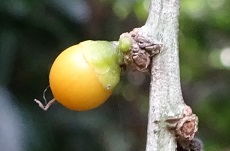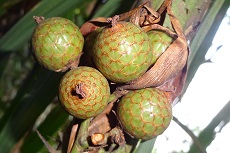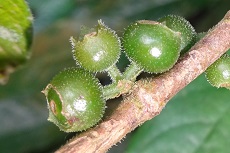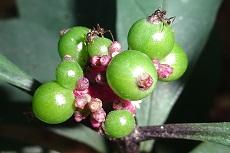| Home | Nature Weekly Index |
17 July 2016 | Field Trip | MacRitchie Forest |
Last week, I finally had a chance to take a relatively short walk at the MacRitchie Forest. This was the first forest walk that I did this year. I was grounded since the beginning of the year and was only able to walk around nearby parks. Needless to say, I was quite happy to be able to be out again in the wild though for only about 2.5 hours.
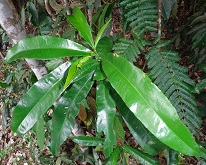
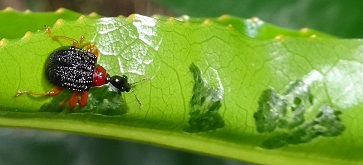 As it was in the early afternoon in a weekday and probably also due to the hot weather, human traffic was very light. The
first insect that I managed to take some pictures was a
Leaf-rolling Weevil (Family: Attelabidae). This happened
to be the second time that I saw this unknown species of weevil; the first time was at Upper Seletar Reservoir area in
July 2014. The added information on the current sighting was its
host plant, Ixonanthes icosandra, where the weevil was found
munching on a young leaf. In the previous occasion, it was seen on the leaf of
Syzygium myrtifolium which was unlikely to be the host plant
since no damage to the leaf was observed.
As it was in the early afternoon in a weekday and probably also due to the hot weather, human traffic was very light. The
first insect that I managed to take some pictures was a
Leaf-rolling Weevil (Family: Attelabidae). This happened
to be the second time that I saw this unknown species of weevil; the first time was at Upper Seletar Reservoir area in
July 2014. The added information on the current sighting was its
host plant, Ixonanthes icosandra, where the weevil was found
munching on a young leaf. In the previous occasion, it was seen on the leaf of
Syzygium myrtifolium which was unlikely to be the host plant
since no damage to the leaf was observed.
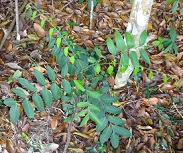
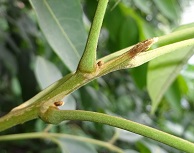
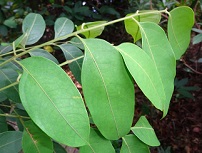 Ixonanthes icosandra was relatively common forest tree around that area. The elongated leaves of the young plants looked
like those from Polyspora singaporeana and
Lithocarpus lucidus. Earlier, I had mistaken it as another forest
tree, Gomphia serrata. Another plant that I managed to unveil its identity was
Trigonachras acuta. Actually, I had already took some pictures of
its fallen orange fruits on the forest floor back in 2008 in Bukit Timah Nature Reserve but the leaves were not visible
then as that tree was very tall. I had seen several of these fruitless tree along the Tree Top Walk trail as well quite a
while back but was not able to secure an identity in the past.
Ixonanthes icosandra was relatively common forest tree around that area. The elongated leaves of the young plants looked
like those from Polyspora singaporeana and
Lithocarpus lucidus. Earlier, I had mistaken it as another forest
tree, Gomphia serrata. Another plant that I managed to unveil its identity was
Trigonachras acuta. Actually, I had already took some pictures of
its fallen orange fruits on the forest floor back in 2008 in Bukit Timah Nature Reserve but the leaves were not visible
then as that tree was very tall. I had seen several of these fruitless tree along the Tree Top Walk trail as well quite a
while back but was not able to secure an identity in the past.
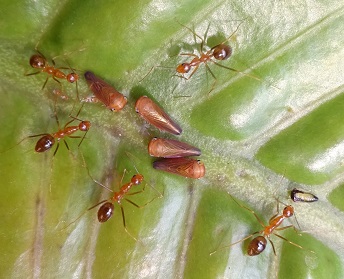 Another interesting insect was a
leafhopper, where a group of them
were gathering on the leaf and stalk of a young Garcinia griffithii plant.
Accompanying them were the
Yellow Crazy Ant (Anoplolepis gracilipes).
There were a total of 5 leafhoppers and 5 ants in the picture shown. One of the leafhoppers, the tiny one on the far right,
was a nymph. In general, ants are good friends of the leafhoppers.
Another interesting insect was a
leafhopper, where a group of them
were gathering on the leaf and stalk of a young Garcinia griffithii plant.
Accompanying them were the
Yellow Crazy Ant (Anoplolepis gracilipes).
There were a total of 5 leafhoppers and 5 ants in the picture shown. One of the leafhoppers, the tiny one on the far right,
was a nymph. In general, ants are good friends of the leafhoppers.
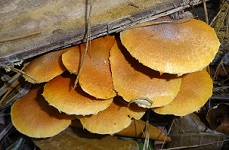
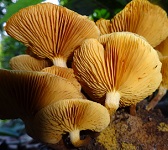 Despite the hot weather, there was a colony of mid-size orange-yellow mushrooms. They were gilled mushrooms under the
Order Agaricales. The typical features of this group of mushrooms are a cap with gill-liked structure underneath that sit
on top of a stem.
Despite the hot weather, there was a colony of mid-size orange-yellow mushrooms. They were gilled mushrooms under the
Order Agaricales. The typical features of this group of mushrooms are a cap with gill-liked structure underneath that sit
on top of a stem.
Below were some fruits from 4 forest plants encountered during the short walk: (1) Hugonia griffithiana (White Grapper Climber), (2) Calamus gracilipes (Giant Devil Palm), (3) Urophyllum streptopodium, and (4) Chassalia curviflora (Curvedflower Chasalis).
